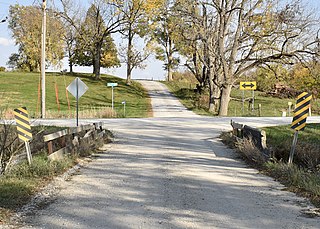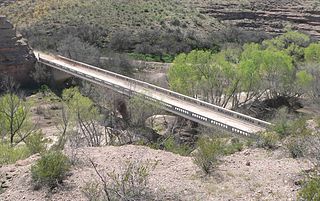
Navajo Bridge is the name of twin steel spandrel arch bridges that cross the Colorado River in the Grand Canyon National Park in northern Coconino County, Arizona, United States. The newer of the two spans carries vehicular traffic on U.S. Route 89A (US 89A) over Marble Canyon between Bitter Springs and Jacob Lake, allowing travel into a remote Arizona Strip region north of the Colorado River including the North Rim of Grand Canyon National Park.

The Lamar Boulevard Bridge is a historic arch bridge carrying Texas State Highway Loop 343 over Lady Bird Lake in downtown Austin, Texas, United States. The bridge features six open-spandrel concrete arches spanning 659 feet (201 m) and carries tens of thousands of vehicles daily across the lake. Completed in 1942, the Lamar Boulevard Bridge was the second permanent bridge to cross the Colorado River, and one of the last Art Deco-style open-spandrel concrete arch bridges built in Texas. The bridge was named an Austin Landmark in 1993 and added to the National Register of Historic Places in 1994.

The Hayden Arch Bridge is a concrete arch bridge on old US 14/US 16 near Cody, Wyoming. It is the only example of its kind in Wyoming. Built in 1924–25, the single-span bridge spans 115 feet (35 m) with two smaller approach arches between rock canyon walls. The bridge carries the Cody-Yellowstone Highway across the Shoshone River with a shallow open-spandrel central arch and nominally arched approach spans. The bridge is named after C. E. Hayden, an engineer with the Wyoming State Highway Department, who designed the bridge and supervised its construction. It was built by H. S. Crocker of Denver, Colorado.

Fossil Creek Bridge is a closed-spandrel deck arch bridge built in the U.S. state of Arizona during 1924–25 on Cottonwood-Camp Verde-Pine road across Fossil Creek. The road, also known as Fossil Creek Road, crosses the creek at a point where it forms the border between Yavapai and Gila counties, and between the Tonto and the Prescott National Forests. The nearest town is Strawberry in Gila County. It is not far from Camp Verde in Yavapai County.

Harrison Avenue Bridge was a concrete deck arch bridge carrying Harrison Avenue in Scranton, Pennsylvania, United States. Its three spans included an open-spandrel ribbed arch over Roaring Brook, flanked by two closed-spandrel arches. The southwestern closed-spandrel arch spanned the former Lackawanna and Wyoming Valley Railroad, converted to highway use in 1964 as the Central Scranton Expressway. The northeastern closed-spandrel arch spans the former Delaware, Lackawanna and Western Railroad, now a heritage railroad operated by Steamtown National Historic Site.
Topeka Bridge & Iron Co. was a bridge company. Its works include many bridges that are now listed on the U.S. National Register of Historic Places. Its Canyon Diablo Bridge was a concrete Luten arch bridge built in 1914. Its Amelia Park Bridge, for another example, was built in 1914.

Daniel B. Luten also known as Daniel Benjamin Luten was an American bridge builder and engineer based in Indianapolis, Indiana.

The Twin Bridges Historic District, in Washington County, Arkansas, near Morrow, is an area surrounding two closed-spandrel, concrete-deck bridges completed in 1922 by the Luten Bridge Company. These bridges are located on County Route 3412 and former County Route 11. The district was added to the National Register of Historic Places on March 7, 1994.

The West Second Street–Swartz Creek Bridge in Flint, Michigan, carries West Second Street over Swartz Creek. It was listed on the National Register of Historic Places in 1999.

The Calamus Creek Bridge near Maxwell, Iowa is a concrete Luten arch bridge constructed in 1905. It was built by N. M. Stark and Company for a cost of $900. It has a 25-foot (7.6 m) single span and a total length of 45 feet (14 m).

Ciénega Bridge is an open-spandrel arch bridge which crosses Ciénega Creek and the Union Pacific Railroad near Vail, Arizona. Originally constructed in 1921, the bridge was part of U.S. Route 80, a major transcontinental highway, from 1926 to 1956. Being the oldest bridge of its kind in Arizona, the Ciénega Bridge is listed on the National Register of Historic Places. Currently, the bridge carries Marsh Station Road.

Lockyer Creek Railway Bridge (Lockyer) is a heritage-listed railway bridge on the Toowoomba - Helidon railway line over Lockyer Creek at Lockyer, Lockyer Valley Region, Queensland, Australia. It was designed by William Pagan and built from 1909 to 1910. It was added to the Queensland Heritage Register on 21 October 1992.

The Evansville-Dutch Mills Road Bridge is a historic bridge in rural western Washington County, Arkansas. It is a single-span concrete filled-spandrel arch bridge, which carries Dutch Mills Road over Whitaker Branch South south of the village of Dutch Mills The bridge was built in 1936 by the Luten Bridge Company, and was one of its last commissions in the county. The arch spans 28 feet (8.5 m) and the bridge has a total structure length of 30 feet (9.1 m). The bridge was built with a unique Luten Company design that used rings to strengthen the connection between the piers and spandrel walls, enabling a reduced amount of material while maintaining the strength of the bridge.

The Harp Creek Bridge is a historic bridge in rural northern Newton County, Arkansas, carrying Arkansas Highway 7 across Harp Creek in the hamlet of Harrison. It is an open-spandrel arch bridge, built out of reinforced concrete in 1928 by the Luten Bridge Company. The arches span 69 feet (21 m), and are mounted on piers set 24 feet (7.3 m) from the abutments. The total structure length is 117 feet (36 m), and the deck is 23 feet (7.0 m) wide. Concrete balustrades line the sides of the bridge.

The Fourche LaFave River Bridge carries Arkansas Highway 7 across the Fourche LaFave River in western Perry County, Arkansas, downstream of the Nimrod Dam. It is a three-span open spandrel concrete arch bridge, with its longest span measuring 184 feet (56 m), and its total length 518 feet (158 m). The arches are mounted on concrete abutments and piers. The bridge deck is asphalt, and is lined by ornate concrete balustrades. It was built in 1941 by the Luten Bridge Company, and is a well-preserved example of style from that period.

The Allentown Bridge is a bridge spanning the Puerco River near Houck, Arizona, located in Apache County. The existing structure was completed in 1923 and is listed on the National Register of Historic Places.

Canyon Diablo Bridge is an abandoned automobile bridge in Coconino County, Arizona, United States, approximately 30 mi (48 km) east of Flagstaff, Arizona. The bridge carried Route 66 over Canyon Diablo. The ghost town of Two Guns, once a prosperous tourist stop, is near the east end of the bridge.

Keigley Branch Bridge is a historic structure located northeast of Gilbert, Iowa, United States. It spans the Keigley Branch for 47 feet (14 m). The Iowa State Highway Commission was re-formed in 1913 and they developed standard designs for smaller bridges. One of their designs was an alternative to the Luten arch. They were built throughout the state in the 1910s and 1920s. This is the oldest remaining arch bridge from that era. The Koss Construction Company of Des Moines completed it in 1913 for $3,384.85. The bridge features a medium-span arch with concrete-filled spandrels, paneled guardrails, a corbeled arch ring, and two-tone concrete detailing. The Keigley Branch Bridge was listed on the National Register of Historic Places in 1998.

The Beach–Garland Street–Flint River Bridge was a historic Luten arch bridge carrying Beach and Garland streets over the Flint River in Flint, Michigan. It was listed on the National Register of Historic Places in 1999. The bridge served from 1921 until 2006.

The Gila River Bridge near Clifton, Arizona, also known as the Clifton Bridge, is a Luten Arch bridge which was built in 1918. It was listed on the National Register of Historic Places in 1988.




















